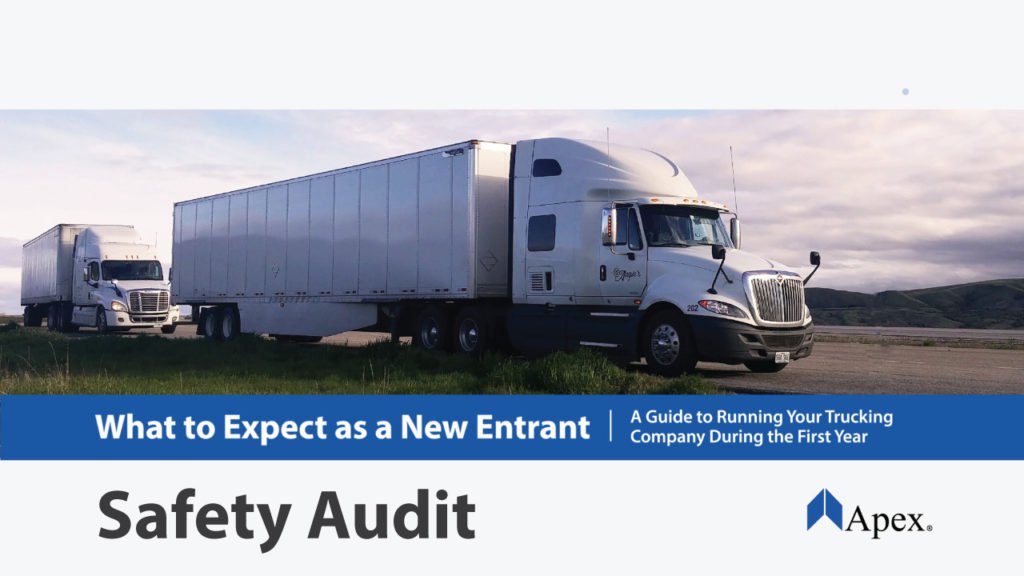A Guide to Your First Year in Trucking
There are a lot of requirements to get your operating authority and start a trucking company. We’ve put together a series of short videos and a free white paper to explain some of the regulations and important topics to know the year after you start your trucking company. One of the biggest milestones for your new trucking company is the New Entrant Safety Audit. The safety audit is something every trucking company needs to schedule and prepare for.
New Entrant Safety Audit
Watch this video to learn about the DOT New Entrant Safety Audit and what you need to do to get permanent operating authority for your new trucking company.
Read the Transcript
This video series, What to Expect as a New Entrant, A Guide to Running Your Trucking Company during the First Year has been developed by Apex Capital to help you understand the policies and procedures that you must have in place in order to pass your safety audit and receive your permanent operating authority.
Today we are talking to Reghan Orman about the Safety Audit. Reghan is Associate General Counsel at Apex Capital and she also leads the Apex Startup Program. A program that’s designed to help those interested in starting a trucking company get their operating authority.
Who can perform a safety audit?
A safety audit can be performed by any US Federal Safety Investigator or any state’s enforcement officer. Generally, safety audits are going to take place at a motor carriers principal place of business.
What is the purpose of the audit?
The purpose of the safety audit is twofold first it helps the FMCSA to gather safety data to assess all new entrants safety performance and adequacy of the safety measurement systems they’ve put in place and second it provides educational and technical assistance to carriers on an ongoing basis.
What can I expect during an audit?
During an audit the FMCSA is going to review the safety management systems that the motor carrier has put into place and that covers a variety of topics including driver qualifications and duty statuses, vehicle maintenance, is the motor carrier maintaining an accident register, and do they have a controlled substance and alcohol testing program in place.
What happens if I don’t pass the safety audit?
If you don’t pass the safety audit as a new entrant that means the FMCSA has come in conducted the audit and they’ve determined that the safety management system and controls that that new entrant has are so inadequate that they’re just going to fail the audit for them. When that occurs the FMCSA is going to send written notice to the new entrant that they are either going to be placed out of service or that their authority is suspended unless they take certain steps to remedy whatever problem that the FMCSA found and they’re going to send that notice to the new entrant within 45 days of the audit. The new entrant then upon receiving that notice should within the next 60 days submit their corrective action plan back to the FMCSA so that they can keep their authority active and not be placed out of service indefinitely.
Once I have been given permanent operating authority, can I expect safety audits in the future?
Once you’re given permanent authority there’s no real annual safety audit like that new entrant that’s going to happen but all motor carriers are going to be continued to be subject to the CSA system so inspect a lot of random inspections, roadside inspections, investigation after possible crashes, and as a result of that there may be some interventions conducted by the FMCSA and of course they can always suspend authority and place the motor carrier out of service.
And another potential audit like scenario is the potential for a compliance review. A compliance reviews happen when either the motor carrier has requested a change in their safety scores or maybe if the FMCSA found a violation during an inspection or somebody has reported what they think to be a violation. After that occurs any motor carrier may be subject to warning letters, roadside inspections, investigations, required again to have some sort of safety action plan put into place, fines, even out of service orders, in ultimate revocation of authority.
Read the Rest of our Series on Your First Year in Trucking:
What is a New Entrant?
Trucking Insurance Requirements
Alcohol & Drug Testing Programs
Taxes for Trucking Companies
International Fuel Tax Agreement (IFTA)
Safety Regulations for Trucking Companies
The Driver Qualification File
All about Hours of Service
New Entrants: Additional Filings
Get a FREE Guide to Running Your Trucking Company During the First Year
To learn more about what to expect in your first year of trucking, including some tips to help you prepare for your DOT New Entrant Safety Audit, download our free white paper here and watch our video series on YouTube.
